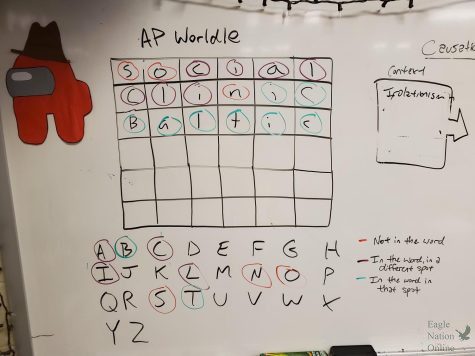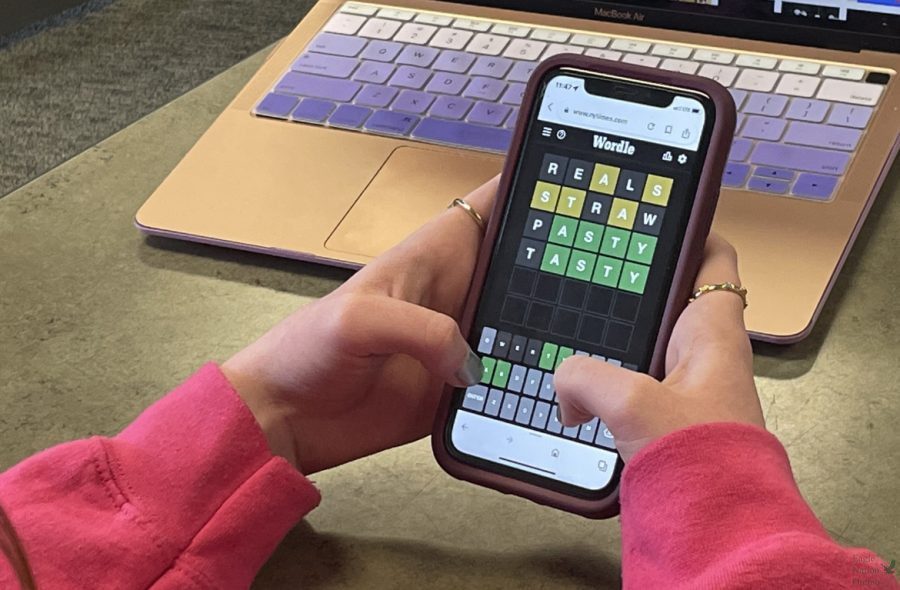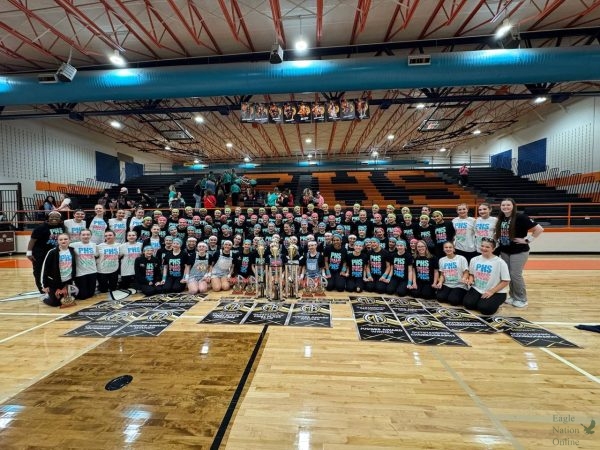‘Wordle’ Reign – How 5-letter-words have taken over the internet
Playing the daily Wordle, a student guesses five-letter-words. Wordle was created by Josh Wardle, and the game revolves around five-letter words that players guess after the different letters turn different colors to show the placement of that letter. “Wardle used to pay around $100 per month to keep the game free for players,” senior and writer Alyssa Clark said. “The game is still free to play.”
Taking over the internet one five-letter-word guess at a time, Wordle has become one of the newest additions to the New York Times online games.
Originally developed by Welsh-born software engineer Josh Wardle, the game started to take off in mid-November after technologist Andy Biao included the link to the game in his blog. Now, according to The New York Times, over 300,000 players work through the puzzle each day.
Sophomore Max Miller found the game during the first snow-in.
“I think the drive of Wordle is that it is simplistic to the point where everybody feels like they can do it, but it is challenging enough to make people recognize the challenge and thus share their success if they find the word,” Miller said. “The fact that everybody could know what word it is and what that word means sparks a competition because it creates a very even playing field, as who wins is then seen as a true winner. As more people hop on the trend, it only makes more people want to guess the word so they can get that recognition.”
Players guess and enter five-letter words, and, depending on the final answer, the letters will turn gray, yellow or green. Gray means the letter is not in the final word, yellow means the letter is in the word, but at a different placement in the word, and green means it’s in the correct placement in the word. Players will have six tries to guess the daily word.
Since it used to be independent, slight changes to the word list have been made. Sophomore Andy Hough believes it’s gotten harder.
“It was so much easier when it was independent,” Hough said.

Other online games from The New York Times include The Crossword, The Mini Crossword, Spelling Bee, Tiles and more, but players need a subscription to the newspaper to play the full versions of these games.
Wardle used to pay around $100 per month to keep the game free for players. However, the game is still free to play.
AP and Honors World History teacher Greg Easley has his own version of Wordle, titled “AP Worldle,” that he runs on his whiteboard with terms relating to the course in his classroom.
“I think it’s great that it’s a puzzle that the entire world all gets to encounter each day,” Easley said. “It’s nice that it’s a game that you can only do once per day, and then it normally only takes up a few minutes. A lot of other mobile games can easily eat up an hour of your time, so I like the brevity of Wordle.”
The original game sparked many new variations and spin-offs, with some of the most popular ones including Nerdle, Worldle, Taylordle, Quordle, Absurdle, Kilordle, Octordle, Letterle and Star Wordle.
AP and Honors Biology teacher Alysha Jaballa plays Wordle with her husband each morning – which the two have made into a competition.
“The New York Times has really upped their vocabulary, and thrown in some real curve balls with foreign words, slang words and words that contain various double letters,” Jaballa said. “It’s still fun regardless, but it certainly keeps you on your toes. It’s been a fun little thing to look forward to each morning. I guessed the word on the first try once, and literally screamed I was that excited.”
Your donation will support the student journalists of Prosper High School. Your contribution will allow us to purchase equipment and cover our annual website hosting costs.

Honors, Experience and Awards:
UIL Journalist, District Qualifier 2019 - 2022
Quill & Scroll Honor Society Member
2 TAJE Honorable Mentions in 2020, 2021
TAJE Best in Texas 2022 - Excellent - Podcast
TAJE Best in Texas 2022 - Honorable Mention - Podcast
TAJE Best in Texas 2022 - Excellent - Sports Column
TAJE Best in Texas 2022 - Excellent - Staff Editorial
ILPC Award Winner for Reviews and Video Packages
Previous Hope Squad Member, Former Social Media Director for ENO
8 Best of SNO Publications















Aaron Strain • Mar 15, 2022 at 9:43 am
Wordle is unreasonably addictive… it has no business being that fun, yet here I am, thinking my day is ruined just because someone spoiled the daily Wordle.
Alyssa Clark • Mar 15, 2022 at 10:09 am
Hi Aaron,
Thanks for reading! I completely agree, Wordle is always a special part of my day too.